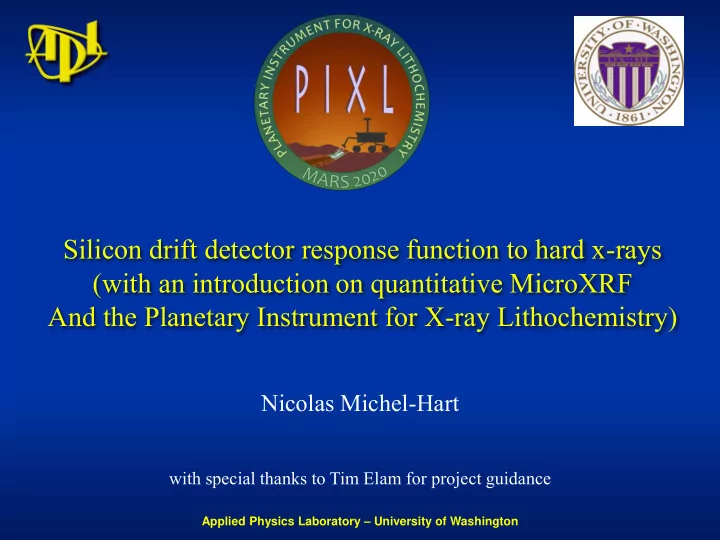

Silicon drift detector response function to hard x-rays (with an introduction on quantitative MicroXRF And the Planetary Instrument for X-ray Lithochemistry) Nicolas Michel-Hart with special thanks to Tim Elam for project guidance Applied Physics Laboratory – University of Washington
X-ray Fluorescence and μ XRF http://in.niton.com/en/ https://xos.com/technologies/xrf/ https://en.wikipedia.org/wiki/X-ray_fluorescence#/media/File:XRFScan.jpg Elam, PIXL Seminar, Nov 2015
Why Micro XRF? Biosignatures (ooids) hosted in a 2.7 billion-year-old carbonate rock Elam, PIXL Seminar, Nov 2015
Some pixels can be very different Area of element maps Visible light image Recent microbialite from the Death Valley Area Elam, PIXL Seminar, Nov 2015
Mars 2020 Mission • M2020 Science Objectives – Habitability: Characterize the geologic record for astrobiologically relevant environments and geologic diversity – Biosignatures: Search for materials with high biosignature preservation potential – Sample Caching: Obtain a pristine set of geologically diverse samples and cache for future return to Earth – Prepare for Humans: Demonstrate in situ resource utilization technologies and characterize dust size and morphology • Mission life: 1.5 Mars years/1005 Martian days • Flight Instruments delivered by Fall 2018, Launch July 2020, Land February 2021 • Instrument Complement: – Mastcam-Z and Supercam for panoramic/stereo imaging and chemical analysis – MEDA for weather – RIMFAX ground penetrating radar – MOXIE technology experiment to produce Oxygen from CO 2 – SHERLOC and WATSON for UV Raman and high resolution imaging – PIXL : Topic of today’s talk and the coolest instrument on the Mars 2020 Mission! 5 http://mars.nasa.gov/mars2020/mission/instruments/ Elam, PIXL Seminar, Nov 2015
Assessing Past Environments PIXL Element Maps 3.45 billion yr old conglomerate deposited on an ancient paleosol Map size = 2 x 1 cm Step size = 150 m m Elam, PIXL Seminar, Nov 2015
Detection of Potential Chemical Biosignatures Element maps reveal concentrated vanadium and copper in the black spot – a potential biosignature in sandstone Sample from Spinks et al. International Journal of Astrobiology, 2010 Elam, PIXL Seminar, Nov 2015
PIXL Science, Data Analysis, and Hardware Team (partial) • Abigail Allwood PI • • Marc Foote IPM Joel Horowitz DPI • • Larry Wade ISE Benton Clark Co-I • • Douglas Dawson XRS Cog-E Tim Elam Co-I • • Moxtek X-ray tube John Grotzinger Co-I • • XOS Polycapillary X-ray Optics Robert Hodyss Co-I • • Amptek Detectors John Jorgensen Co-I • • Steve Battel HVPS Scott McLennan Co-I • • Eric Hertzberg HVPS Michael Tice Co-I • • University of Michigan HVPS Allan Treiman Co-I • • Danish Technical University Camera System David Flannery Co-I • Yang Liu PS PIXL breadboard NIST 612 spectrum Element maps of Martian meteorite NWA 7034 Elam, PIXL Seminar, Nov 2015
The Problem • Significant low energy counts when using high energy sources is not understood • Differences observed in soft and hard x-ray output functions using the same detectors • SDD response functions well researched and modeled for low energy x-rays • Not so for high energy x-rays W. T. Elam, unpublished raw data, 2015 F. Scholze, M. Procop, X-Ray Spectrometry. 2009, 38, 312-321
Hypothesis Any photon incident to the detector will have one of four fates: 1. Photon is fully absorbed, its full energy is captured by the detector 2. Photon passes through the detector with no interaction, no energy is captured by the detector 3. Photon scatters inelastically in the detector, the scattered photon is then absorbed without escaping the detector. All of the incident photon energy is captured by the detector and measured as one count. 4. Photon scatters inelastically in the detector; the scattered photon then escapes the detector with no subsequent interactions. Only the energy transferred to an electron during the scattering event is captured and measured by the detector. We think case #4 is the cause of low energy counts being registered when there are no low energy photons present.
The physics of the four processes Input photon beam absorption ( L ) N N ( 1 e ) absorbed 0 Photon Compton scattering Z 2 2 d 1 cos ) 2 2 2 c r S x , Z sin 1 ( 1 cos ) 1 cos e d 1 1 cos Z d dN c d L atomic d N 1 e d Scattered photon and electron energy 1 E E scattered 0 1 1 cos 1 cos E E electron 0 1 1 cos Scattered photon escape ( EL ) N N e escape _ photon escape scattered https://universe-review.ca/R15-12-QFT10.htm
Numerical modeling of the problem • We don’t have access to a monochromatic source • Must work backwards from the experimental source peak to derive the incident x-ray beam • Number of electrons contributing to the compton scattering response calculated numerically • Energy of each electron is calculated • Compton response and source peak response are summed as the total response function d D det ector _ thickness E E C ( d dD ) max atomic ( D ) ( EL d incident _ photon escape _ photon N N e 1 e e d dDdE scattered _ electrons 0 , E E 0 D 0 0 1 cos E E electron 0 1 1 cos
Experimental Data
Comparison of model and experiment Looks pretty good!
What's next? • Design and run a better experiment: higher counts, cleaner data • Statistical comparison of model and experimental data to quantify the accuracy of the model • Send this thing to Mars and check out some rocks
Thank you & any questions???
Recommend
More recommend